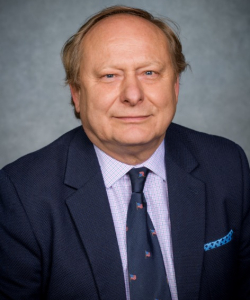
Slominski, Andrzej, M.D., Ph.D.
Principle Investigator
Andrzej T. Slominski is an Endowed Professor of Dermatology and Senior Scientist at Comprehensive Cancer Center Cancer Chemoprevention Program, University of Alabama at Birmingham and dermatopathologist as the VA medical Center since 2015. He obtained his MD and PhD from the Medical University of Gdansk. After being forced to emigrate from Poland he went on to the Yale University where he received training in pigment cell and melanoma biology under Aaron B Lerner and John Pawelek. He finished his residency in pathology and fellowship in dermatopathology under Martin Mihm in Albany Medical Center, Albany, New York, and became board certified in AP and DP.
In 2009 he received Commander Order of Polonia Restituta and in 2021 the Cross of Freedom and Solidarity in 2021 for his past activity in Poland contributing in the end of the communist system in the Eastern Europe.
Dr. Slominski has so many novel discoveries that invoke the complexities of the human body and provide a testimony to his unique, highly integrative mind. For example, his singular work defining the skin as a neuro-immuno-endocrine organ breaks the current dogmas and has led to groundbreaking discoveries in vitamin D biology and photobiology with far reaching implications in other areas of medicine. Another novel discovery integrating the skin with the rest of the body is that he was the first to show that UVB can activate different centers in the brain that in turn regulates systemic function in a manner independent from the pituitary. These include stimulation of brain production of CRH, urocortin, β-endorphin, ACTH and α-MSH. He was the first to define skin as the corticosteroidogenic organ, demonstrating that skin cells can synthesize steroids from cholesterol locally. He was the first to show that skin expresses a serotoninergic and melatoninergic system to defend against environmental stressors. However, he is most famous for his novel discovery of previously unrecognized pathways of vitamin D activation and completely new secosteroidogenic/sterologenic pathways. He also defined their products and mechanism of action, biological activities, and health implications. These novel discoveries are re-writing textbooks on vitamin D and pave the way for new advances in science. His body of work offers new perspectives on the interaction between skin, body and the mind regulated by solar radiation. He received continuous research funding through NIH, VA, and DOD. He published more than 471 peer reviewed scientific papers.
He organized and served as a Chair or co-Chair of several International Conferences as well as a member of the organizing Committees. He is also a member of the editorial boards of the Experimental Dermatology, Scientific Reports, Anticancer Research, Cancer Diagnosis & Prognosis, Polish Annals of Medicine, Melanoma Management, International Journal of Molecular Sciences, Medicina, Molecules, International Journal of Oncology, Translational Oncology, Polish Journal of Pathology and was a member of the Journal of Pineal Research and PLOS One. He trained eight dermatopathology fellows, more than 21 postdoctoral fellows, more than 13 graduate students, more than 45 undergraduate students and served on several PhD and MS committees, being also a member of the residency committee for pathology and member of CGHS Curriculum and UTMG Credentialing Committees at the UTHSC. His academic and research qualities have been recognized internationally and nationally, as documented by invitations to serve as a key-note speaker on prestigious international scientific conferences, to hold administrative functions in the IFPC, PASPCR, MSR and ASDP and to organize or serve as the member of organizing committees for the International or National Scientific Conferences.
He was elected to be the full member of the World Academy of Sciences in 2018, was elected as a member of the Polish Academy of Arts and Sciences in 2020. In 2022 he received Honorary Doctorate (Doctor Honoris Causa) from the Jagiellonian University, Krakow, Poland. This University was founded in 1364 and Nicolaus Copernicus was one of its graduates.
Administratively, he served as a Director of Dermatopathology at the Loyola Medical Center, UTHSC and previously as the program director for the Dermatopathology Fellowship program at the UAB. He served as a Council member and Secretary Treasurer for the Pan-American Pigment Cell Society (PASPCR), and as a past Secretary for the International Federation of Pigment Cell Societies (IFPCS), member of the Steering Committee of the Melanoma Society for Research and the Chair of the Continuing Education and Research Committee, American Society of Dermatopathology. Currently, he serves as the Secretary of the IFPCS representing PASPCR at this International Federation of Pigment Cell Societies.
Lab Staff

Tae-Kang Kim
Researcher Senior

Zorica Janjetovic
Researcher Senior

Senthilkumar Ravichandran
Researcher V